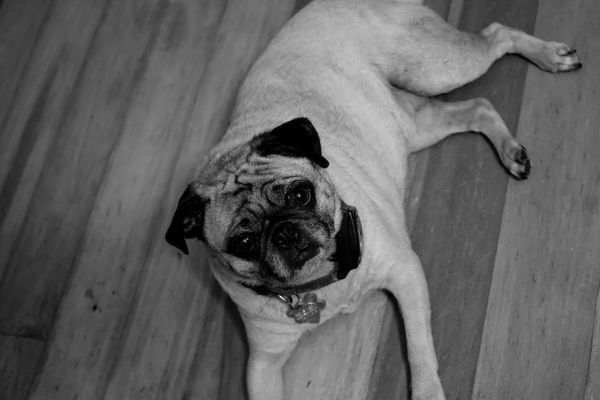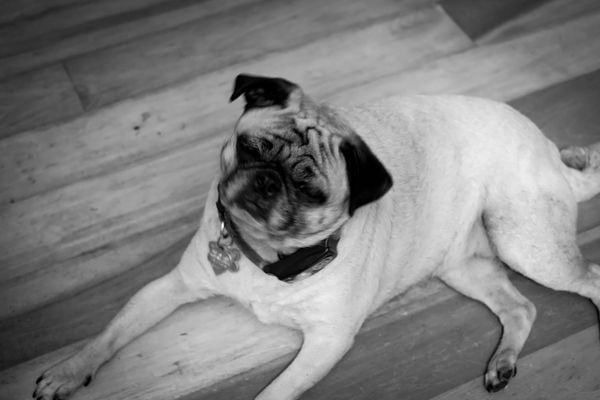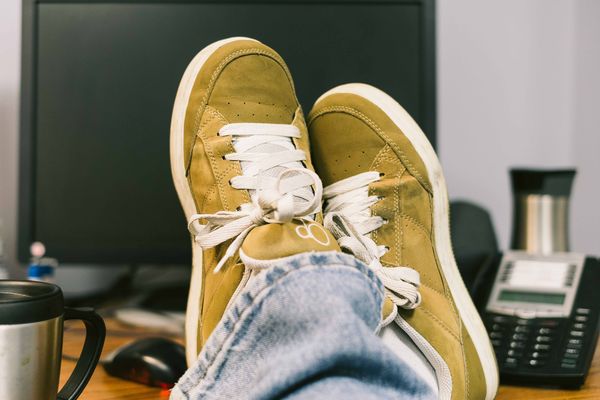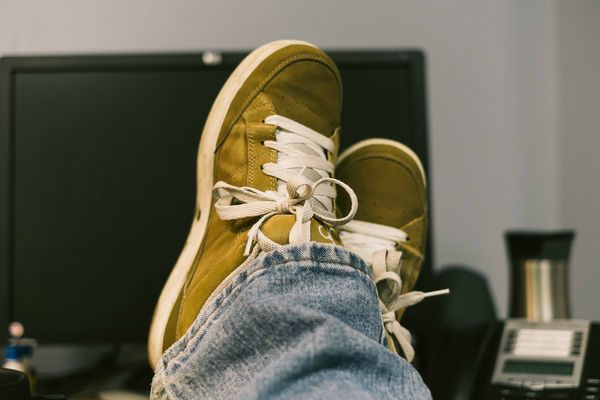The in-camera meter...one reason to override it.
Sep 9, 2013 05:19:27 #
This is not being posted to start a flame war on meters but only to illustrate a point about reflective metering for those noobs who don't quite get what is happening when they point their camera at something.
I was just testing my camera's high ISO ability so I was taking low light shots at ISO 12,800.
These two shots were taken seconds apart, same conditions of course, all I did was rotate the camera to get a better framing.
It's not art..as I said, just a test, and Gracie happened to be sitting next to me.
But I want to use this set of images to illustrate why setting a manual base exposure might be a good thing to learn to do.
In both images I set the camera to:
ISO 12,800
f/3.2
SS = A (auto)
That means that I set the ISO, I set the shutter speed and let the camera chose a shutter speed that it thought would produce a good exposure.
In the first shot it chose a shutter speed of 1/105 based on what tones were in it's field of view at the time.
After taking shot #1, I rotated the camera and [b]took the second shot less than 20 seconds later. Same settings.[b]/
The camera chose a shutter speed of 1/40 based on the change in tones within it's field of view.
So what really changed in the shot? The amount of light falling on Gracie?
No....actually nothing changed...but the camera didn't know that because it reads reflective light...and apparently the range of tones shifted enough that that's what it now thought was a good metering job.
You can see that the 1/105 was enough to freeze her motion, but in the second one, it wasn't...resulting in a "bad" shot.
If this were (for example) an important occasion and I got home and found that half of my shots were blurred because the camera thought that the exposure was changing and reacted by slowing the shutter speed, I'd be sorely disappointed!
So...which is actually the correct exposure?
According to my hand held meter it's 1/125 at that ISO so neither exposures that the camera chose were really correct...they were just "close" or "pretty far away" depending on what tones were being metered.
I only post this to illustrate some of the issues that are being talked about on this site at the moment and to suggest that there is an alternative way to meter that might work better for you.
The "poor man's" way to do this is to meter off of the palm of your hand in the light that you are going to use and then set the camera to manual mode using those settings. Another way is to find a neutral shade/tone and meter off of that and then set the camera to manual mode with those settings. An example of a neutral tone you can use is green grass.
The advantage of metering and then setting a manual exposure that is that things like this don't happen...your exposures stay consistent in the same conditions and you don't get nasty surprises....like slow shutter speeds when not necessary AND you can do like the Ronco Chicken roaster guy on tv..
set it...and forget it!
You meter off of your hand or a representative surface and then you set the camera up and forget it! Shoot away! (unless you move to a different environment or the light changes significantly, but then you just adjust and keep shooting)
It means that you have to set your camera up and prepare ahead of time, when you get to that birthday party and you are going to take pictures in the dining room of the cake....set it up...or when you are going to the HS football game...meter the grass and set it up...
It's not the ONLY way to do it but it's a good way and it reminded me of the reason that I shoot in manual mode frequently.
I was just testing my camera's high ISO ability so I was taking low light shots at ISO 12,800.
These two shots were taken seconds apart, same conditions of course, all I did was rotate the camera to get a better framing.
It's not art..as I said, just a test, and Gracie happened to be sitting next to me.
But I want to use this set of images to illustrate why setting a manual base exposure might be a good thing to learn to do.
In both images I set the camera to:
ISO 12,800
f/3.2
SS = A (auto)
That means that I set the ISO, I set the shutter speed and let the camera chose a shutter speed that it thought would produce a good exposure.
In the first shot it chose a shutter speed of 1/105 based on what tones were in it's field of view at the time.
After taking shot #1, I rotated the camera and [b]took the second shot less than 20 seconds later. Same settings.[b]/
The camera chose a shutter speed of 1/40 based on the change in tones within it's field of view.
So what really changed in the shot? The amount of light falling on Gracie?
No....actually nothing changed...but the camera didn't know that because it reads reflective light...and apparently the range of tones shifted enough that that's what it now thought was a good metering job.
You can see that the 1/105 was enough to freeze her motion, but in the second one, it wasn't...resulting in a "bad" shot.
If this were (for example) an important occasion and I got home and found that half of my shots were blurred because the camera thought that the exposure was changing and reacted by slowing the shutter speed, I'd be sorely disappointed!
So...which is actually the correct exposure?
According to my hand held meter it's 1/125 at that ISO so neither exposures that the camera chose were really correct...they were just "close" or "pretty far away" depending on what tones were being metered.
I only post this to illustrate some of the issues that are being talked about on this site at the moment and to suggest that there is an alternative way to meter that might work better for you.
The "poor man's" way to do this is to meter off of the palm of your hand in the light that you are going to use and then set the camera to manual mode using those settings. Another way is to find a neutral shade/tone and meter off of that and then set the camera to manual mode with those settings. An example of a neutral tone you can use is green grass.
The advantage of metering and then setting a manual exposure that is that things like this don't happen...your exposures stay consistent in the same conditions and you don't get nasty surprises....like slow shutter speeds when not necessary AND you can do like the Ronco Chicken roaster guy on tv..
set it...and forget it!
You meter off of your hand or a representative surface and then you set the camera up and forget it! Shoot away! (unless you move to a different environment or the light changes significantly, but then you just adjust and keep shooting)
It means that you have to set your camera up and prepare ahead of time, when you get to that birthday party and you are going to take pictures in the dining room of the cake....set it up...or when you are going to the HS football game...meter the grass and set it up...
It's not the ONLY way to do it but it's a good way and it reminded me of the reason that I shoot in manual mode frequently.
1/105 shutter speed

1/40 shutter speed

Sep 9, 2013 05:40:55 #
This hit's home.
I took 4 shots at the Weather vain today I need two to create the 3D photo. One of the reasons for taking extra shots is the first and the second shot are often different exposures, and today the third.
I was lucky 2 and 4 matched in exposure without moving to far.
This is going to cut my 4-6 shots down to 3-4 less without wind, Thanks :thumbup:
I took 4 shots at the Weather vain today I need two to create the 3D photo. One of the reasons for taking extra shots is the first and the second shot are often different exposures, and today the third.
I was lucky 2 and 4 matched in exposure without moving to far.
This is going to cut my 4-6 shots down to 3-4 less without wind, Thanks :thumbup:
Sep 9, 2013 06:29:13 #
Very interesting test and thank you for sharing. You did not mention what type of metering your camera was set for, could that have also had an effect on the outcome?
JoeB
JoeB
Sep 9, 2013 06:34:57 #
I am not wishing to take away from your valid message but in all fairness to your camera you were using spot metering which, given the wide contrast range of the face of your doggie, would have more easily fooled the metering system. Your post suggests that the use of a hand held incident light meter would be preferable which if were to be adopted would require both additional cost and more stuff to carry around. Maybe you could write up a method for people which provides a simple and reliable way to best use the camera's metering system as an incident metering alternative.
Sep 9, 2013 06:52:07 #
winterrose wrote:
I am not wishing to take away from your valid mess... (show quote)
Well...thanks for letting me know that..I usually keep my camera on multi-meter...a faux paux for sure...and you are correct..that's partially what skewed the results.
The basic idea is still the same though.....I might have to do this over again.
I did give an alternative to using a hand held meter in my post...either do the "palm of the hand" meter and set your camera or find a neutral tone like green grass if you're outside and set the camera base on that...an incident meter is not the ONLY way, just the most accurate way.
PS: Palm of hand says that this should be 1/125
1/75 shutter speed

1/40 shutter speed

Sep 9, 2013 06:56:36 #
rpavich wrote:
Well...thanks for letting me know that..I usually ... (show quote)
You know the palm of the hand method and I know the palm of the hand method.....What about a good write up for those who don't? Might be a very useful bit of knowledge....
Sep 9, 2013 07:03:13 #
winterrose wrote:
You know the palm of the hand method and I know the palm of the hand method.....What about a good write up for those who don't? Might be a very useful bit of knowledge....
For those that don't know...the "palm of the hand" method of determining exposure is this:
fill your frame with the palm of your hand and half press the shutter button...take note of what the camera says is the proper exposure.
Now set your camera to manual for that exposure; shutter speed, f/stop, and ISO....and voila!...pretty darn close with no incident meter.
Here is an image of my shoes at 1/125 (what the palm of the hand said the real exposure should be)
1/125 shutter speed

Sep 9, 2013 08:01:51 #
rpavich wrote:
For those that don't know...the "palm of the hand" method of determining exposure is this:
fill your frame with the palm of your hand and half press the shutter button...take note of what the camera says is the proper exposure.
Now set your camera to manual for that exposure; shutter speed, f/stop, and ISO....and voila!...pretty darn close with no incident meter.
Here is an image of my shoes at 1/125 (what the palm of the hand said the real exposure should be)
fill your frame with the palm of your hand and half press the shutter button...take note of what the camera says is the proper exposure.
Now set your camera to manual for that exposure; shutter speed, f/stop, and ISO....and voila!...pretty darn close with no incident meter.
Here is an image of my shoes at 1/125 (what the palm of the hand said the real exposure should be)
What if you are seated in the shadows of a stadium and the players are under bright floodlights? How would the palm of the hand incident metering method be applied then?
Sep 9, 2013 08:05:07 #
winterrose wrote:
What if you are seated in the shadows of a stadium and the players are under bright floodlights? How would the palm of the hand incident metering method be applied then?
It wouldn't. I'd meter off of the grass...then set the camera to manual.
The "palm of the hand" method is for when you (the photog) and your subject are in the same light...both sun, both shade, etc.
Sep 9, 2013 20:16:40 #
[quote=rpavich]This is not being posted to start a flame war on meters but only to illustrate a point about reflective metering for those noobs who don't quite get what is happening when they point their camera at something.
I was just testing my camera's high ISO ability so I was taking low light shots at ISO 12,800.
These two shots were taken seconds apart, same conditions of course, all I did was rotate the camera to get a better framing.
It's not art..as I said, just a test, and Gracie happened to be sitting next to me.
But I want to use this set of images to illustrate why setting a manual base exposure might be a good thing to learn to do.
In both images I set the camera to:
ISO 12,800
f/3.2
SS = A (auto)
That means that I set the ISO, I set the shutter speed and let the camera chose a shutter speed that it thought would produce a good exposure.
In the first shot it chose a shutter speed of 1/105 based on what tones were in it's field of view at the time.
After taking shot #1, I rotated the camera and [b]took the second shot less than 20 seconds later. Same settings.[b]/
The camera chose a shutter speed of 1/40 based on the change in tones within it's field of view.
So what really changed in the shot? The amount of light falling on Gracie?
No....actually nothing changed...but the camera didn't know that because it reads reflective light...and apparently the range of tones shifted enough that that's what it now thought was a good metering job.
You can see that the 1/105 was enough to freeze her motion, but in the second one, it wasn't...resulting in a "bad" shot.
If this were (for example) an important occasion and I got home and found that half of my shots were blurred because the camera thought that the exposure was changing and reacted by slowing the shutter speed, I'd be sorely disappointed!
So...which is actually the correct exposure?
According to my hand held meter it's 1/125 at that ISO so neither exposures that the camera chose were really correct...they were just "close" or "pretty far away" depending on what tones were being metered.
I only post this to illustrate some of the issues that are being talked about on this site at the moment and to suggest that there is an alternative way to meter that might work better for you.
The "poor man's" way to do this is to meter off of the palm of your hand in the light that you are going to use and then set the camera to manual mode using those settings. Another way is to find a neutral shade/tone and meter off of that and then set the camera to manual mode with those settings. An example of a neutral tone you can use is green grass.
The advantage of metering and then setting a manual exposure that is that things like this don't happen...your exposures stay consistent in the same conditions and you don't get nasty surprises....like slow shutter speeds when not necessary AND you can do like the Ronco Chicken roaster guy on tv..
set it...and forget it!
You meter off of your hand or a representative surface and then you set the camera up and forget it! Shoot away! (unless you move to a different environment or the light changes significantly, but then you just adjust and keep shooting)
It means that you have to set your camera up and prepare ahead of time, when you get to that birthday party and you are going to take pictures in the dining room of the cake....set it up...or when you are going to the HS football game...meter the grass and set it up...
It's not the ONLY way to do it but it's a good way and it reminded me of the reason that I shoot in manual mode frequently.[/quote]
Thanks for sharing this. I really appreciate all the good advice I can get.
I was just testing my camera's high ISO ability so I was taking low light shots at ISO 12,800.
These two shots were taken seconds apart, same conditions of course, all I did was rotate the camera to get a better framing.
It's not art..as I said, just a test, and Gracie happened to be sitting next to me.
But I want to use this set of images to illustrate why setting a manual base exposure might be a good thing to learn to do.
In both images I set the camera to:
ISO 12,800
f/3.2
SS = A (auto)
That means that I set the ISO, I set the shutter speed and let the camera chose a shutter speed that it thought would produce a good exposure.
In the first shot it chose a shutter speed of 1/105 based on what tones were in it's field of view at the time.
After taking shot #1, I rotated the camera and [b]took the second shot less than 20 seconds later. Same settings.[b]/
The camera chose a shutter speed of 1/40 based on the change in tones within it's field of view.
So what really changed in the shot? The amount of light falling on Gracie?
No....actually nothing changed...but the camera didn't know that because it reads reflective light...and apparently the range of tones shifted enough that that's what it now thought was a good metering job.
You can see that the 1/105 was enough to freeze her motion, but in the second one, it wasn't...resulting in a "bad" shot.
If this were (for example) an important occasion and I got home and found that half of my shots were blurred because the camera thought that the exposure was changing and reacted by slowing the shutter speed, I'd be sorely disappointed!
So...which is actually the correct exposure?
According to my hand held meter it's 1/125 at that ISO so neither exposures that the camera chose were really correct...they were just "close" or "pretty far away" depending on what tones were being metered.
I only post this to illustrate some of the issues that are being talked about on this site at the moment and to suggest that there is an alternative way to meter that might work better for you.
The "poor man's" way to do this is to meter off of the palm of your hand in the light that you are going to use and then set the camera to manual mode using those settings. Another way is to find a neutral shade/tone and meter off of that and then set the camera to manual mode with those settings. An example of a neutral tone you can use is green grass.
The advantage of metering and then setting a manual exposure that is that things like this don't happen...your exposures stay consistent in the same conditions and you don't get nasty surprises....like slow shutter speeds when not necessary AND you can do like the Ronco Chicken roaster guy on tv..
set it...and forget it!
You meter off of your hand or a representative surface and then you set the camera up and forget it! Shoot away! (unless you move to a different environment or the light changes significantly, but then you just adjust and keep shooting)
It means that you have to set your camera up and prepare ahead of time, when you get to that birthday party and you are going to take pictures in the dining room of the cake....set it up...or when you are going to the HS football game...meter the grass and set it up...
It's not the ONLY way to do it but it's a good way and it reminded me of the reason that I shoot in manual mode frequently.[/quote]
Thanks for sharing this. I really appreciate all the good advice I can get.
Sep 9, 2013 20:29:40 #
rpavich wrote:
It wouldn't. I'd meter off of the grass...then set the camera to manual.
The "palm of the hand" method is for when you (the photog) and your subject are in the same light...both sun, both shade, etc.
The "palm of the hand" method is for when you (the photog) and your subject are in the same light...both sun, both shade, etc.
I hope you didn't mind me being that specific rpavich, I think that you will agree that it's pretty important to say that because unless you provide all the information the concept can be misinterpreted. Cheers, Rob.
Sep 10, 2013 02:36:32 #
winterrose wrote:
I hope you didn't mind me being that specific rpavich, I think that you will agree that it's pretty important to say that because unless you provide all the information the concept can be misinterpreted. Cheers, Rob.
Yep...true.
Sep 10, 2013 03:13:01 #
uuuh? how? Rebel T3 and T2i Its very bright outside I'm in the pecan trees shooting the squirrels, you set the OSI and let the camera set the shutter speed. Ok, HOW?
Is that A-dep, M, AV, TV, P or CA?
Then your going to make a change so that You! can set the shutter speed, and, I guess maintain the same OSI. HOW?
If your on manual don't that mean you set everything? your saying that on manual the camera chooses the speed unless I do something? what the heck is it?
Ever time a leaf blows on the tree I get a different exposure.
Wasn't that noticeable till you said something now it's driving me nut's.
When I shoot a wedding( I don't) and half my photos are ruined is it because I was on full auto?
Or because I was on manual, went inside and did not check the camera to see it the pics were OK by resetting the shutter speed?
Is the bad half from the inside pictures or like your shoe and the Grace Kelly, just random changes?
What setting was that and what are the benefits of using it if the shots come out different?
Is that A-dep, M, AV, TV, P or CA?
Then your going to make a change so that You! can set the shutter speed, and, I guess maintain the same OSI. HOW?
If your on manual don't that mean you set everything? your saying that on manual the camera chooses the speed unless I do something? what the heck is it?
Ever time a leaf blows on the tree I get a different exposure.
Wasn't that noticeable till you said something now it's driving me nut's.
When I shoot a wedding( I don't) and half my photos are ruined is it because I was on full auto?
Or because I was on manual, went inside and did not check the camera to see it the pics were OK by resetting the shutter speed?
Is the bad half from the inside pictures or like your shoe and the Grace Kelly, just random changes?
What setting was that and what are the benefits of using it if the shots come out different?
Sep 10, 2013 04:30:56 #
Pictxterowner wrote:
uuuh? how? Rebel T3 and T2i Its very bright outsid... (show quote)
I really do recommend that in your case you just leave your camera set to Auto everything. Rob.
Sep 10, 2013 12:21:35 #
"This is not being posted to start a flame war on meters but"..but..but....BUT...BUT???????
If you want to reply, then register here. Registration is free and your account is created instantly, so you can post right away.





